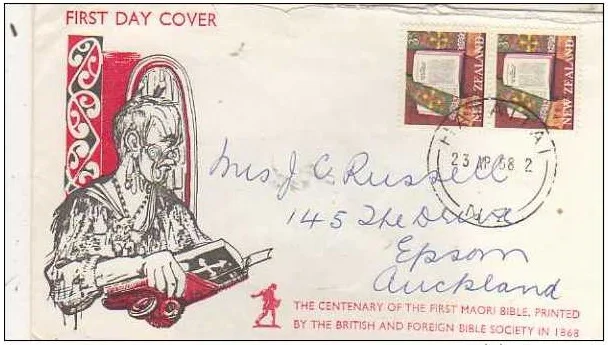In order to commemorate the 100th anniversary of the first printing of the
Bible in the Maori language, this special stamp was produced.
3c - Bible at Rangiatea Maori Church, Otaki.
This stamp depicts Bishop Hadfield's personal bible, opened at the book of Deuteronomy and resting on a carved kauri lectern in the Rangiatea Maori Church at Otaki. The green satin sashes depicted on the stamp are hand embroidered in a pink fuchsia design which in Maori interpretation signifies "opportunity". The border on the sashes is the hammerhead shark scroll design signifying "prestige".
The design is from a photograph, adapted by the Public Relations Division, G.P.O., Wellington.
Translation of the Bible in Maori.
The Bible was translated into the Maori language in the 19th century by missionaries sponsored by the Church Missionary Society. In 1826 the Rev. William Williams started work on the translation of the Bible into the Māori language. The Rev. Robert Maunsell worked with William Williams on the translation of the Bible. William Williams concentrated on the New Testament; Maunsell worked on the Old Testament, portions of which were published in 1827, 1833 and 1840 with the full translation completed in 1857. In July 1827 the first Māori Bible was printed comprising 3 chapters of Genesis, the 20th chapter of Exodus, the 1st chapter of the Gospel of St John, 30 verses of the 5th chapter of the Gospel of St Matthew, the Lord’s Prayer and some hymns. William Gilbert Puckey also collaborated with William Williams on the translation of the New Testament, which was published in 1837 and its revision in 1844.
The first edition of the full Māori Bible was published in 1868. Since then, there have been four revisions of the full Bible at intervals of 21 years, 36 years and finally 27 years up to the 1952 edition. The New Zealand Bible Society has a vision for a new translation of the Bible into modern colloquial Māori.
Printing Errors.
Left-hand Stamp - Gold colour is 100% omitted.
Right-hand stamp - Gold shifted up so far the writing is off the design.
A second example of an upward gold shift in a selvage block of four.
First Day Cover Collection.
Below is a small collection of six First Day Covers.
All dated 23 April, 1958.
This is one of two designs shown here that depicts a Maori Warrior reading a Bible.
Two stamps seems to be more than would be required for postage within New Zealand.
This cover uses the same photograph used in designing of the stamp. Makes a nice looking cover too.
There is that same Maori Warrior cover but in this case being sent overseas to Scotland.
Notice how the 1967 - 20c Taniwha was selected for added postage while using a Maori theme.
Another version of a Maori Warrior reading the bible is the main feature of this cover. What is of more
interest to me is that it is addressed to Cameron Highlands in what is now known as Malaysia.
interest to me is that it is addressed to Cameron Highlands in what is now known as Malaysia.
I am rather surprised that 3c was enough to get this letter to the USA.
Compare it with the cover below that used two stamps for postage to the USA.
Out of these four cover designs I believe this one tells us the most about the event celebrated by this stamp issue.
Technical information:
Date of Issue:
|
23 April 1968
|
|---|---|
Designers:
|
New Zealand Post Office, Wellington
|
Printers:
|
Thomas De La Rue, England
|
Stamp Size:
|
28mm x 24.5mm
|
Sheet Size:
|
100 stamps per sheet
|
Process:
|
Delacryl
|
Performance Gauge:
|
13
|
Paper Type:
|
Chalk surfaced, NZ and star watermark
|
Some of the images in this post were used with permission from the illustrated catalogue of StampsNZ
You can visit their web site and On-line Catalogue at, http://stampsnz.com/










So the first translation was finished in 1857 while it was not published until 1868. Why the delay of over 10 years?
ReplyDeleteRoss.
That is a good question Ross.
DeleteI suppose getting a suitable printing press for such a large undertaking might have been a problem. Pick up a bible sometime and just look at the size of it, the number of pages and words. I think you might realise want a major feat this was for men who didn't really has assess to equipment that they'd have in more developed parts of the world.
Allan
Hi Team.
ReplyDeleteI like the details in this post. Also that is a nice collection of First Day Covers too.
Question - Why was it necessary to translate the Bible to a Maori printed form. If a Maori was going to take the trouble to learn to read then he/she might as well learn English.
Tam
Consider at the presenting of the Treaty at Waitangi, more Maori could read in te reo Maori than English could read English. It served our Maori people to better acquaint themselves with the God of heaven, His Son Jesus and the good news of the Gospel in our own language given the understanding of our own native tongue rather than a foreign one. As Peter said in the Word, I became ALL things to ALL men to share the Gospel of Christ, the outpouring of the Holy Spirit is a good example of the Word being preached and heard by the hearers of many nations in their own native tongue. Hope this aids towards clarifying and providing a more comprehensible explanation to your query, Tam...
ReplyDeleteThanks Terri,
DeleteYou make some good points. It cleared up things from me too. I come from Japan and so struggle with some parts of early New Zealand history. I wondered that translating the Bible into Maori also served as a text book for teaching the reading of Maori too.
Anne